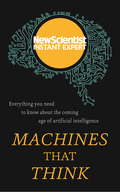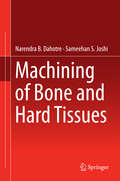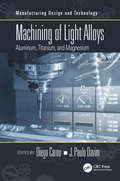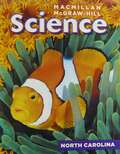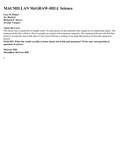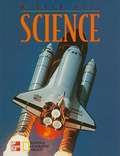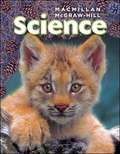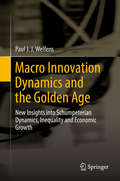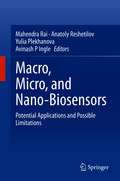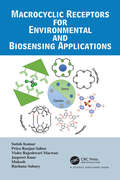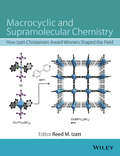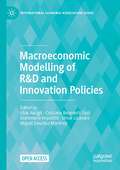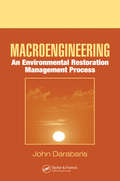- Table View
- List View
Machines that Think: Everything you need to know about the coming age of artificial intelligence (Instant Expert Ser.)
by New ScientistSometime in the future the intelligence of machines will exceed that of human brain power. So are we on the edge of an AI-pocalypse, with superintelligent devices superseding humanity, as predicted by Stephen Hawking? Or will this herald a kind of Utopia, with machines doing a far better job at complex tasks than us? You might not realise it, but you interact with AIs every day. They route your phone calls, approve your credit card transactions and help your doctor interpret results. Driverless cars will soon be on the roads with a decision-making computer in charge. But how do machines actually think and learn? In Machines That Think, AI experts and New Scientist explore how artificial intelligence helps us understand human intelligence, machines that compose music and write stories - and ask if AI is really a threat.ABOUT THE SERIESNew Scientist Instant Expert books are definitive and accessible entry points to the most important subjects in science; subjects that challenge, attract debate, invite controversy and engage the most enquiring minds. Designed for curious readers who want to know how things work and why, the Instant Expert series explores the topics that really matter and their impact on individuals, society, and the planet, translating the scientific complexities around us into language that's open to everyone, and putting new ideas and discoveries into perspective and context.
Machines that Think: Everything you need to know about the coming age of artificial intelligence (New Scientist Instant Expert)
by New ScientistSometime in the future the intelligence of machines will exceed that of human brain power. So are we on the edge of an AI-pocalypse, with superintelligent devices superseding humanity, as predicted by Stephen Hawking? Or will this herald a kind of Utopia, with machines doing a far better job at complex tasks than us? You might not realise it, but you interact with AIs every day. They route your phone calls, approve your credit card transactions and help your doctor interpret results. Driverless cars will soon be on the roads with a decision-making computer in charge. But how do machines actually think and learn? In Machines That Think, AI experts and New Scientist explore how artificial intelligence helps us understand human intelligence, machines that compose music and write stories - and ask if AI is really a threat.ABOUT THE SERIESNew Scientist Instant Expert books are definitive and accessible entry points to the most important subjects in science; subjects that challenge, attract debate, invite controversy and engage the most enquiring minds. Designed for curious readers who want to know how things work and why, the Instant Expert series explores the topics that really matter and their impact on individuals, society, and the planet, translating the scientific complexities around us into language that's open to everyone, and putting new ideas and discoveries into perspective and context.
Machining of Bone and Hard Tissues
by Narendra Dahotre Sameehan JoshiThis book provides an in-depth review of state-of-the-art orthopaedic techniques and basic mechanical operations (drilling, boring, cutting, grinding/milling) involved in present day orthopaedic surgery. Casting a light on exploratory hybrid operations, as well as non-conventional techniques such as laser assisted operations, this book further extends the discussion to include physical aspects of the surgery in view of material (bone) and process parameters. Featuring detailed discussion of the computational modeling of forces (mechanical and thermal) involved in surgical procedures for the planning and optimization of the process/procedure and system development, this book lays the foundations for efforts towards the future development of improved orthopaedic surgery. With topics including the role of bone machining during surgical operations; the physical properties of the bone which influence the response to any machining operation, and robotic automation, this book will be a valuable and comprehensive literature source for years to come.
Machining of Light Alloys: Aluminum, Titanium, and Magnesium (Manufacturing Design and Technology)
by J. Paulo Davim Diego CarouAluminium, magnesium and titanium are alloys of special interest for engineering applications in a wide range of sectors such as aeronautics, automotive and medical. Their low density, along with sufficient mechanical properties, makes them especially adequate for sectors such as transportation allowing diminishing weight less fuel consumption and emissions to the atmosphere. <P><P>Nowadays, machining is still one the most important manufacturing processes, not only for metal parts, but also for specially designed hybrid parts for more demanding new applications. A wide range of valuable research has been done on the machining of conventional engineering materials. However, when dealing with light alloys and hybrid materials containing them, they need to face new challenges. Particularly, it is important to analyse the suitability of the machining of these alloys in the current context of Industry 4.0, focusing on the development of cost-effective and sustainable processes. <P><P>This book is a comprehensive source on the machining of light alloys, presenting a collection of both experimental and review studies. The work is arranged in eight chapters, presented by a group of international scholars, which analyse the main problems related to the machining of these alloys from different perspectives. <P><P>Key Features <li>A comprehensive state-of-the-art reference source on machining of light alloys <li>Provides research on conventional and non-conventional machining process <li>Offers current research topics on sustainable machining <li>Presents research on the machining of hybrid materials using light alloys <li>Includes applications for Industry 4.0 environments <P><P>Machining of Light Alloys: Aluminum, Titanium, and Magnesium The aim of the book is to serve as a tool for helping researchers and practitioners to face machining challenges and facilitating the development of new industrial applications for light alloys.
Macmillan McGraw Hill Science
by Lucy H. DanielMacmillan/McGraw-Hill Science employs a unique lesson plan to develop science concepts three ways: through purposeful, hands-on activities; compelling reading content; and dynamic visuals and graphics. Key partnerships include Sally Ride Science and TIME For Kids.
Macmillan McGraw Hill Science: Grade 5 Unit B Living Things and Their Environment
by Lucy Daniel Jay Hackett Richard Moyer JoAnne VasquezMacmillan McGraw Hill Science Grade 5 Unit B Living Things and Their Environment by Richard Moyer, Jay Hackett, Lucy Daniel, and JoAnne Vasquez.
Macmillan McGraw-Hill Science
by Richard H. Moyer Joanne Vasquez Jay Hackett Pamela Stryker H. Prentice Baptiste Lucy H. DanielExtensively dealing with the subject of Science, this book covers Life Science, Physical Science and Earth Science.
Macmillan McGraw-Hill Science (Grade #5)
by Richard H. Moyer Joanne Vasquez Jay Hackett Lucy H. DanielThis McGraw-Hill Science (Grade 5) contains unit lessons on Life Science, Living Things, Earth Science, and Physical Science.
Macmillan McGraw-Hill Science (Grade #6)
by Richard H. Moyer Joanne Vasquez Jay Hackett Lucy H. DanielScience is a way of understanding the world around us. The work of scientists often begins when scientists ask questions about something they observe. Asking and answering questions is the basis of inquiry.
Macmillan McGraw-Hill Science (Grade 3, North Carolina Edition)
by Richard H. Moyer Joanne Vasquez Jay Hackett Lucy H. DanielScience is a way of understanding the world around us. Scientists often ask questions about what they observe. They call on many skills to help them answer these questions.
Macmillan McGraw-Hill Science 2nd Grade
by Richard H. Moyer Joanne Vasquez Jay Hackett Lucy H. DanielA level 2 science book with lots of activities and illustrations.
Macmillan McGraw-Hill Science 3rd Grade
by Lucy Daniel Joanne Vasquez Jay Hackett Richard Moyer Pamela Stryker H. Prentice BaptisteThis textbook goes into broad details on life, earth and physical science.
Macmillan McGraw-Hill Science 4th Grade
by Richard H. Moyer Joanne Vasquez Jay Hackett Lucy H. DanielThis study material contains topics on Life Science, Earth Science and Physical Science.
Macmillan McGraw-Hill Science 5th Grade
by Richard H. Moyer Joanne Vasquez Jay Hackett Lucy H. DanielMacmillan McGraw-Hill Science contains unit lessons on Life Science, Living Things, Earth Science, Physical Science, etc.
Macmillan/McGraw-Hill Science (Grade #3)
by Richard H. Moyer Joanne Vasquez Jay Hackett Lucy H. DanielThird grade science textbook.
Macro Innovation Dynamics and the Golden Age
by Paul J. J. WelfensThis book takes a new look at the golden age in neoclassical growth theory and explores in detail sustainability and optimum growth in China, the US and Europe. Innovation, foreign direct investment, trade and growth dynamics are key elements in modern economies - including perspectives on green growth and aspects of the knowledge production function in the context of multinational companies. As such the book considers the role of foreign direct investment in a modified growth model and discusses innovation in an enhanced Mundell-Fleming macro model. Moreover, for the first time it directly links a knowledge production function to the macro production function in a broader context, including real money balances in the production function. It shows - also with empirical relevance - that FDI inward stocks relative to the GDP of host countries, the number of researchers and per capita income are relevant drivers of new knowledge and the stock of knowledge, respectively. This new Schumpeterian theoretical approach lends itself to important policy conclusions for both OECD members and newly industrialized countries.
Macro, Micro, and Nano-Biosensors: Potential Applications and Possible Limitations
by Mahendra Rai Avinash P. Ingle Anatoly Reshetilov Yulia PlekhanovaThis book includes an international group of researchers who present the latest achievements in the field of enzyme, immune system, and microbial and nano-biosensors. It highlights the experimental evidence for formation of biological fuel cells (BFCs)-which has a dual purpose – as a device that produces electricity and the systems which produce it simultaneously cleaning up the environment from polluting organic compounds. Considering the work in the field of macro, micro and nano-biosensors, considerable attention is paid to the use of nanomaterials for the modification of working electrodes. Nanomaterials in some cases can significantly improve the parameters of analytical systems. Readers will be interested in the projection of the presented theoretical and experimental materials in the field of practical application of modern analytical developments. The presented results in many cases imply the possibility of using the created models of macro, micro and nano-biosensors, and biofuel elements in the field of health, and protection/restoration of the environment. It includes information about all existing types of transducers of signals in biosensors – electrochemical, optical and quantum-optics, thermoelectric, data of atomic force microscopy, piezoelectric, and more. On the basis of these principles, descriptions are given about the functioning of macro, micro and nano- biosensors for the detection of compounds used in medicine, detection of compounds that clog the environment, and thus affect human health, for compounds that are potentially the basis for the production of drugs, for the selection of compounds that have medicinal activity, for immunodetection, and to assess the quality of food. These questions form the basis of research carried out in the field of biosensors in the world. Since the described models of biosensors have high sensitivity, high measurement speed and selectivity, the described results attract the attention of both the ordinary reader and business class specialists who create and implement analytical technologies. This book is very useful for researchers in life sciences, chemical sciences, physics, and engineering. In addition, it will be useful for the persons working in industry. Advanced technologies specialists will be attracted by the novelty of the proposed solutions and their relevance and ease of implementation. Since the studies contain sections describing the parameters of different biosensors, BFCs, they are easily navigated into assessing the effectiveness of the practical use of the proposed device. The relevant sections indicate such characteristics as detection ranges, life span, type of biological material used, the method of formation of the bio-receptor part. These parameters are of interest to both developers of new models of biosensors and BFC, and their manufacturers.
Macro-Glycoligands
by Xue-Long SunThis volume details methods and protocols for the synthesis and characterization of glycopolymers and their biomedical applications. Chapters are divided into three parts covering synthesis and characterization of glycopolymers; glycopolymer-nanoparticle conjugates; and surface immobilized glycopolymers. Written for the Methods in Molecular Biology series, chapters include introductions to their respective topics, lists of the necessary materials and reagents, step-by-step, readily reproducible laboratory protocols, and tips on troubleshooting and avoiding known pitfalls. Authoritative and practical, Macro-Glycoligands: Methods and Protocols aims to ensure successful results in the further study of this vital field.
Macro-engineering Seawater in Unique Environments: Arid Lowlands and Water Bodies Rehabilitation
by Viorel Badescu Richard CathcartThe subjects refer to histories of ancient and modern use of seacoasts; possible macro-projects capable of massive changes in the coastlines of the Dead Sea, Red Sea and Persian Gulf caused by canal and massively scaled hydropower dam installations; relevant macro-projects for the Black Sea and Baltic Sea; possibilities of refreshment of the Aral Sea and Iran's Lake Uremia with seawater or river freshwater importation macro-projects; potential rehabilitation of some vital arid zone regions now dominated by moving or movable surface granular materials using unique and unusual macro-projects; seawater flooding of land regions situated below present-day global sea-level; harnessing energy and obtaining freshwater from the world's salt-laden ocean by modern industrial means; various macro-projects designed specifically for the protection (reduction of vulnerability) of particular Earth geographical regions.
Macrocyclic Polyamines: Synthesis and Applications
by Ji Zhang Xiaoqi YuThe first comprehensive book focusing on synthesis and applications of macrocyclic polyamines and their derivatives Macrocyclic polyamines are a class of widely used important compounds. This is the first book that systematically summarizes the synthesis and applications of macrocyclic polyamines and their analogues, including the properties and synthetic methods of macrocyclic polyamines, chemical nucleases based on macrocyclic polyamines, the derivatives of macrocyclic polyamines as nano-vector materials, macrocyclic polyamines derivatives for bio-imaging, chemical sensors based on macrocyclic polyamines, and other applications of macrocyclic polyamines. Macrocyclic Polyamines: Synthesis and Applications includes most of the studies involving macrocyclic polyamines and their derivatives, and may be used as a reference for the researchers in related fields. It offers in-depth coverage of cyclization modes; special procedures for tetraza macrocyclic compounds; diacids-diamines condensation; oxidative DNA cleaving by macrocyclic polyamines; lipids with cationic MPA headgroups; the derivatives of DOTA, DO3A, and PCTA; receptors for anions; sensors for bioactive molecules; macrocyclic polyamines for solvent extraction and membrane transport of amino acids and their derivatives, electrophoretic separation, and open-tubular CEC; and much more. The first book that systematically summarizes the chemistry of macrocyclic polyamines and their derivatives in terms of synthetic methods for their preparation, functionalization, and application in the main fields of chemical sensors, chemical nucleases, drug-delivery, bio-imaging and vector materials Provides a comprehensive reference for the researchers working on macrocyclic polyamines Offers train of thought in related research fields such as organic chemistry, coordination chemistry, analytical chemistry, supramolecular chemistry, biomaterials, etc. Macrocyclic Polyamines: Synthesis and Applications will not only provide a reference for the researchers working on macrocyclic polyamines, but also offer opportunities for researchers in related research fields to understand the benefits of these key compounds.
Macrocyclic Receptors for Environmental and Biosensing Applications
by Satish Kumar Jaspreet Kaur Priya Ranjan Sahoo Violet Rajeshwari Macwan Mukesh Rachana SahneyThe book is designed to highlight the utility of supramolecular systems in diverse areas such as sensing of ionic and molecular analytes, aggregation, artificial molecular machines, biology, and medicine. The synthetic chemistry of a diverse set of supramolecules encompassing various supramolecular interactions involved in driving macrocyclic architectures is discussed. Attempts have been made to cover unique features of macrocycles viz. control over shape, size, and valency along with supramolecular interactions, which direct complex supramolecular systems. The book also provides a discussion on the similarity between macrocyclic host-guest systems and biomolecules, which lay the foundation of building modern artificial molecular motors and switches like protein machines for application in diverse areas. The authors hope that the book will appeal to a wider audience of students and researchers in academics and/or industries.
Macrocyclic and Supramolecular Chemistry: How Izatt-Christensen Award Winners Shaped the Field
by Reed M. IzattThis book commemorates the 25th anniversary of the International Izatt-Christensen Award in Macrocyclic and Supramolecular Chemistry. The award, one of the most prestigious of small awards in chemistry, recognizes excellence in the developing field of macrocyclic and supramolecular chemistry Macrocyclic and Supramolecular Chemistry: How Izatt-Christensen Award Winners Shaped the Field features chapters written by the award recipients who provide unique perspectives on the spectacular growth in these expanding and vibrant fields of chemistry over the past half century, and on the role of these awardees in shaping this growth. During this time there has been an upsurge of interest in the design, synthesis and characterization of increasingly more complex macrocyclic ligands and in the application of this knowledge to understanding molecular recognition processes in host-guest chemistry in ways that were scarcely envisioned decades earlier.
Macroeconomic Modelling of R&D and Innovation Policies (International Economic Association Series)
by Ufuk Akcigit Cristiana Benedetti Fasil Giammario Impullitti Omar Licandro Miguel Sanchez-MartinezThis open access book encompasses a collection of in-depth analyses showcasing the challenges and ways forward for macroeconomic modelling of R&D and innovation policies. Based upon the proceedings of the EC-DG JRC-IEA workshop held in Brussels in 2017, it presents cutting-edge contributions from a number of leading economists in the field. It provides a comprehensive overview of the current academic and policy challenges surrounding R&D as well as of the state-of-the-art modelling techniques.The book brings to the forefront outstanding issues related to the assessment of the macroeconomic impact of R&D policies and its modelling. It speaks to the rising importance of R&D and innovation policy, and the proliferation of macroeconomic models featuring endogenous technological change.The contents of this book will be of interest to both academic and policy audiences working in the fields of R&D and innovation.
Macroengineering: An Environmental Restoration Management Process (Systems Innovation Book Ser.)
by John DarabarisMacroengineering: An Environmental Restoration Management Process provides a comprehensive understanding of all the technical, cost, and regulatory issues that an environmental project manager would potentially face on a large scale environmental restoration project. The author addresses unique technical issues encountered during DOD and DOE environmental cleanup efforts, such as radionuclide contamination, unexploded ordinance, heavy metals, and other common contaminants. Referencing the most recent regulations and practices in environmental cleanup projects, the book also includes useful charts and tables and serves both as a classroom text and a professional reference.
